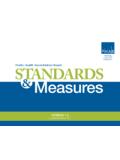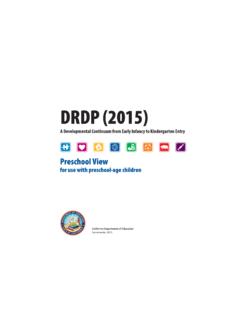Transcription of FOUR DOMAINS FOR RAPID SCHOOL IMPROVEMENT
1 FOUR DOMAINS FOR RAPID SCHOOL IMPROVEMENTA Systems Framework The Center on SCHOOL Turnaround at WestEd About the Center on SCHOOL Turnaround (CST). The CST is one of 7 national Content Centers in a federal network of 22 Comprehensive Centers. The Department of Education charges the centers with building the capacity of state education agencies (SEAs) to assist districts and schools in meeting student achieve-ment goals. The goal of the CST is to provide technical assistance and to identify, synthesize, and disseminate research-based practices and emerging promising practices that will lead to the increased capacity of SEAs to support districts in turning around their lowest-performing work was supported by the Center on SCHOOL Turnaround through funding from the Department of Education, PR/Award Number S283B120015.
2 It does not necessarily reflect the views or policies of the Department of Education, and no endorsement by the federal government should be assumed. Copyright 2017 WestEd. All rights citation: The Center on SCHOOL Turnaround. (2017). Four DOMAINS for RAPID SCHOOL IMPROVEMENT : A systems framework [The Center for SCHOOL Turnaround at WestEd]. San Francisco, CA: of this framework was a group effort in every way. Contributing writers were Coby V. Meyers, Sam Redding, Dallas Hambrick Hitt, Carlas McCauley, Lenay Dunn, Katy Chapman, Eric Ambroso, and Min Chen-Gaddini. Contributing reviewers included Lauren Morando Rhim, Kathleen Ryan Jackson, Dean Fixsen, Caryn Ward, William Robinson, and Julie Corbett.
3 The Center on SCHOOL Turnaround leadership team also thanks WestEd s Nikola Filby and John Rice for their thoughtful review and 1 The Framework: Responsibility at Each Level of the Education System 2 domain 1: Turnaround Leadership 4 Practice 1A: Prioritize IMPROVEMENT and communicate its urgency 5 Practice 1B: Monitor short- and-long term goals 6 Practice 1C: Customize and target support to meet needs 7 Framework Self-Reflection for domain 1: Turnaround Leadership 8 References for domain 1 and its Practices 9 domain 2: Talent Development 11 Practice 2A: Recruit, develop, retain, and sustain talent 12 Practice 2B: Target professional learning opportunities 13 Practice 2C: Set clear performance expectations 14 Framework Self-Reflection for domain 2: Talent Development 15 References for domain 2 and its Practices 16 domain 3: Instructional Transformation 18 Practice 3A: Diagnose and respond to student learning needs 19 Practice 3B: Provide rigorous evidence-based instruction 20 Practice 3C: Remove barriers and provide opportunities 21 Framework Self-Reflection for domain 3: Instructional Transformation 22 References for domain 3 and its Practices 23 domain 4.
4 Culture Shift 25 Practice 4A: Build a strong community intensely focused on student learning 26 Practice 4B: Solicit and act upon stakeholder input 27 Practice 4C: Engage students and families in pursuing education goals 28 Framework Self-Reflection for domain 4: Culture Shift 29 References for domain 4 and its Practices 30 Conclusion 32 domain - and Practice-Specific References 33 domain 1: Turnaround Leadership 33 domain 2: Talent Development 35 domain 3: Instructional Transformation 38 domain 4: Culture Shift 41 Appendix: Project Methods 441 IntroductionStruggling schools, along with the many local and state efforts to improve them, are noth-ing new.
5 But the challenge to make dramatic and sustainable improvements in our lowest performing preK-12 schools first gained national attention in 2001 with the advent of No Child Left Behind and its restructuring mandate. In 2009, the Obama administration then extended that challenge, making RAPID and significant SCHOOL IMPROVEMENT , commonly referred to as SCHOOL turnaround, a top priority under the Department of Education s SCHOOL IMPROVEMENT Program and its Elementary and Secondary Education Act waivers. Yet despite a continued and intense local, state, and federal focus on turnaround over the past 15 years, IMPROVEMENT efforts have yielded mixed results, with individual turnaround schools appearing as islands of excellence in a sea of otherwise frustrated expectations.
6 What educators and policymakers have learned during this period of intense focus on turn-around is that the always-challenging endeavor of significantly improving the performance of individual schools is most likely to be successful when receiving support from beyond the individual SCHOOL and its community. RAPID IMPROVEMENT can be bolstered or stalled by the system within which a SCHOOL operates, a system that, in addition to the SCHOOL itself, encom-passes the state education department and the local district. To the extent that this broader system state, district, SCHOOL is recast to actively support dramatic SCHOOL IMPROVEMENT across the board, it will allow us to progress beyond the current state of having islands of excellence to a point where all schools are able to provide all students with the education they support educators in creating such systems, the Center on SCHOOL Turnaround at WestEd (CST) has developed a framework to assist states, districts, and schools in leading and man-aging RAPID IMPROVEMENT efforts.
7 The framework shares, in practical language, the critical practices of successful SCHOOL turnaround in four DOMAINS , or areas of focus, that research and experience suggest are central to RAPID and significant IMPROVEMENT : turnaround lead-ership, talent development, instructional transformation, and culture shift. At a more fine-grained level, the framework then offers examples of how each practice would be put into action at each level of the system. The framework was created by a CST task force, with input from CST s leadership team as well as from members of the Network of State Turnaround and IMPROVEMENT Leaders (NSTIL) Advisory Council, which includes SEA personnel from across the country who are responsible for SCHOOL turnaround in their respective state.
8 The framework is based on what has been learned from the research on turnaround, including lessons from IMPROVEMENT work under NCLB and promising practices from among the SIG efforts, as well as from the experience of CST s turnaround experts and partners. (For more information about the underlying methods, see the appendix.)When conscientiously and collectively put into action, the practices identified within the DOMAINS may lead to progress across those areas. Implemented effectively, the practices in the framework should not only help students assigned to failing schools, but, by creating a system that better supports students in these schools, should have a cascading effect that improves the ecosystem of all schools.
9 The intended audience for this framework are SEA staff and district and SCHOOL leaders. Four DOMAINS for RAPID SCHOOL IMPROVEMENT : A Systems Framework 2 The framework was drafted before the advent of Every Student Succeeds Act (ESSA) pro-visions explicitly requiring that interventions for the lowest performing schools meet one of the top three levels of The framework is not intended to meet the highest ESSA evidence standards or to lay out a series of interventions; rather, its purpose is to organize and provide a framing for the field s learnings about RAPID SCHOOL IMPROVEMENT efforts and about how IMPROVEMENT decisions made at any level could have a lasting impact across every level of the framework reflects the understanding that local context and implementation influence the outcomes of any IMPROVEMENT It further reflects lessons learned from the fed-eral SCHOOL IMPROVEMENT Grants program:3 a successful SCHOOL turnaround requires a systems approach with coherent guidance and support from the state and district to complement the actions of the SCHOOL .
10 And a successful SCHOOL turnaround is more than the initial jolt of bold changes in struc-ture, authority, and personnel; it includes phases in which effective practices and processes are routinized and sustained. Furthermore, turnaround has proven to be hard work; it is not a linear process with defined steps that guarantee positive results. This framework should not be seen as a magic bul-let. As stated previously, context matters in terms of implementation and impact. Instead, this framework organizes the issues that state, district, and SCHOOL leaders should consider when planning for a successful and sustainable turnaround. Decisions about what practices to implement when, and how, should take into account the particular needs and context of a turnaround framework reflects the multifaceted and interrelated aspects of turnaround as currently understood; it will evolve as further research clarifies and affirms the components of a suc-cessful SCHOOL turnaround.





